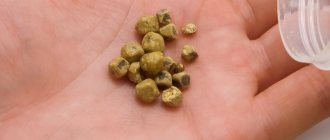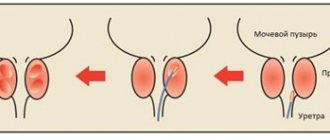Everyone has heard about kidney and bladder stones, but few people know that they can also form in the prostate. These solid inclusions consist of salts, tissue cells lining the ducts of the organ and frozen prostatic secretion - the liquid that makes up the sperm.
If such formations are detected, the patient is diagnosed with calculous prostatitis.
Prostate stones: symptoms and signs
The symptoms are not pathognomonic only for calculous prostatitis; they can also occur with other genitourinary diseases in men, which requires a full clinical and urological examination.
Signs of the presence of stones in the prostate are as follows:
- discomfort in the perineum;
- painful erection and ejaculation;
- decrease or absence of seminal fluid during orgasm;
- sluggish stream of urine;
- blood in semen;
- frequent urination in small portions;
- decreased potency;
- early ejaculation;
- discomfort during defecation;
- the presence of sand inclusions in the sperm;
- recurrent infections of the urogenital tract.
Common symptoms include weakness, chills, low-grade fever with accompanying low-grade inflammation.
Important
Calculous prostatitis is not a life-threatening condition, but certainly worsens its quality.
How to understand that stones have formed in the urethra
The severity of symptoms depends on the number, size and shape of the stones. It also matters how long they stay in the urethra. When a stone blocks the lumen of the urethra, characteristic signs of the disease appear. The main symptoms of stones in the urethra in women and men include:
- dispersion or weakening of the urine stream;
- pain and difficulty urinating;
- acute urinary retention;
- pain when walking and sitting, radiating to the perineum.
With a large number of small tumors, complete or partial incontinence may occur. In some cases, the temperature rises, general weakness and chills occur, for which there are no compelling external reasons. During sexual intercourse, pain occurs, which over time leads to decreased libido and sexual dysfunction.
Prostate stones: what are they and what are they?
The process of stone formation with the primary mechanism occurs due to the fact that the secretion cannot leave the gland due to a violation of the architectonics of the ducts against the background of tissue hyperplasia in BPH or chronic inflammation. It is believed that the secretion then hardens and becomes overgrown with salts of various chemical compositions.
Based on their composition, the following stones are distinguished:
- phosphates;
- urates;
- oxalates;
- calcifications;
- mixed forms.
A stone in the prostate is an accumulation of crystals, proteins, necrotic masses, which is caused by congestion - stagnation of prostatic secretions in the acini (excretory ducts of the prostate gland) against the background of circulatory disorders of the pelvic organs. Stone formation in the prostate gland is caused by urine entering the prostatic ducts (urethral-prostatic reflux). Microbes actively multiply in a stagnant environment, which is considered one of the mechanisms of stone formation. This is typical for secondary stone formation.
It should be noted that some men with prostate calcification never experience pain or discomfort.
Diagnostic measures
Prostate stones can be diagnosed by rectal palpation of the prostate gland by a surgeon or urologist.
Ultrasound diagnostics (preferably TRUS) will most likely determine the presence of stones in the prostate.
Ultrasound of the kidneys and bladder with monitoring of residual urine will allow us to assess the degree of obstruction of the lower urinary tract and the processes of nephrourolithiasis in other organs of the genitourinary tract.
If a concomitant tumor process is suspected, magnetic resonance imaging of the pelvic organs is used.
Laboratory diagnosis of calculous prostatitis
The list of required tests includes the following:
Clinical analysis of blood and urine. Since stones often form not only in the prostate gland, there may be changes in the urine: leukocyturia, proteinuria, crystalluria and bacteriuria. A general blood test may show signs of inflammation: leukocytosis and accelerated erythrocyte sedimentation rate (ESR).- Prostate secret. The secretion of the prostate gland with prostate stones contains erythrocytes, leukocytes, and bacteria. Red blood cells enter the juice due to trauma to the vessels of the gland during the massage necessary to take the secretion. Therefore, for the sake of clarity, some urologists prefer to study ejaculate obtained through masturbation.
- Test for STIs. Testing for sexually transmitted infections (STIs) allows you to confirm or exclude sexually transmitted diseases that indirectly contribute to the process of stone formation in the prostate. It is preferable to perform PCR diagnostics for STIs, since today this is the most accurate way to detect infections transmitted during sex.
- Bacterial sowing Culture of prostate secretion or ejaculate to determine the bacterial flora and sensitivity to antibacterial drugs is an important point for the further treatment regimen. Regarding the determination of prostate-specific blood antigen in a man with prostate stones, it must be borne in mind that the result may be higher than normal, but this does not indicate prostate cancer.
To establish a diagnosis, all examination data obtained, including TRUS and MRI data, are evaluated.
Important
Sometimes prostate calcifications are signs of genitourinary tuberculosis, so consultation with a phthisiourologist is mandatory.
Treatment of prostate stones in Volgograd
APPOINTMENT WITH DOCTOR OLEG VIKTOROVICH AKIMOV
Why can stones form in the prostate gland in men?
Prostate stones occur only in men, since only the stronger sex has a prostate gland. There are many reasons for the formation of stones in the prostate. However, experts identify the following main causes of prostatolithiasis:
- chronic inflammation of the prostate gland;
- irregular sex life;
- a sedentary lifestyle that can lead to stagnation;
- injuries to the genitourinary system, leading to dysfunction;
- self-medication with drugs of the sulfonamide group, for example biseptol;
In addition, experts say that one of the reasons for the appearance of stones in the prostate is poor diet, abuse of fatty and spicy foods, use of salt in large quantities and non-compliance with healthy eating rules.
Research shows that prostate stones are a common condition. The detection rate of stones has increased significantly with the use of ultrasound diagnostic methods. The presence of stones in the prostate increases with age. There is a connection between the formation of prostate stones and chronic pelvic pain syndrome. Crystallographic analysis has shown that the core of prostate stones, in the vast majority of cases, consists of calcium phosphate
What symptoms can there be if you have prostate stones?
- Long-term course of chronic prostatitis with frequent exacerbations.
- Complaints of pain in the pubic region and perineum, which intensifies when sitting on a hard surface, during ejaculation and after sexual intercourse.
- The appearance of pain while traveling on shaking vehicles. The pain often intensifies after massage of the prostate gland.
- The appearance of blood in semen.
- Changes in the prostate gland, that is, the appearance of compactions, painful sensations when palpating and severe pain when trying to massage.
- Changes during ultrasound examination.
How can prostate stones be diagnosed?
The diagnosis must be confirmed using ultrasound or x-ray. Digital rectal examination allows you to find a dense area in the prostate tissue, sometimes crepitus can be detected. If any changes are detected, they will need to be differentiated from prostate tuberculosis and prostate cancer. It is very important that an accurate diagnosis be established. Ultrasound examination can detect hyperechoic areas. In the photo, prostate stones are usually about 3 mm. 70% of patients already have multiple prostate stones. X-ray examination is effective in 30% of cases, in other cases they are not visible. For better visualization, the patient may need to undergo a CT or MRI of the pelvis. Before removing prostate stones non-surgically, a mandatory examination is: bacteriological examination of the ejaculate, analysis for STIs, general urine analysis, clinical blood test, biochemical blood test (urea, creatinine, residual nitrogen), PSA, trace element composition of blood (K, Na, P ,Fe,Cu,Zn,Ca).
How are prostate stones treated? How are prostate stones removed?
At the first suspicion of an inflammatory process in the prostate, men should seek qualified help from a specialist. Only after a thorough diagnosis can the optimal treatment path be chosen, which will lead to the desired result - removal of stones from the prostate and complete restoration of normal functioning of the prostate gland. The high frequency of detection of chronic calculous prostatitis forces us to pay close attention to the development of treatment methods aimed at reducing or removing prostate stones, since the presence of the latter significantly complicates the treatment of the inflammatory process in the prostate gland. Prostate stones have a traumatic effect on surrounding tissues, contribute to microcirculation disorders and mechanical blockage of the excretory ducts of the acini of the gland and support chronic inflammation due to the formation of microbial biofilms on their surface.
Today, treatment of prostate stones is carried out in two directions: conservative and surgical. Various physiotherapeutic procedures and taking medications that improve blood microcirculation and help improve function help achieve good results in the treatment of prostatitis. As a rule, massage of the prostate if there are stones in it is not carried out, as there is a risk of damage to the walls of this gland.
Removal of prostate stones must be comprehensive and affect all aspects of the disease mechanism. Usually takes at least 3 months. During treatment, a regular schedule of sexual activity is recommended. The complex therapy for the removal of prostate stones includes the following substances: disodium salt of ethylenediaminetetraacetic acid to provide a litholytic (destructive) effect and dimethyl sulfoxide, which has a pronounced transporting, anti-inflammatory and analgesic effect. Disodium salt of ethylenediaminetetraacetic acid belongs to the group of complexons - substances capable of forming complex compounds and then converting them into soluble states. This makes it possible to use the disodium salt of ethylenediaminetetraacetic acid for diseases accompanied by excessive deposition of calcium salts in the body, including in the tissues of the prostate gland. EDTA is a low-toxic substance and does not undergo decomposition or any change in the biological environment. In the world medical literature there is a lot of data on the successful use of EDTA salts in detoxification programs, treatment of atherosclerosis, arthrosis, and urolithiasis.
What methods of physiotherapy are used for prostatitis and prostate stones?
Andro-Gyn is a device for physiotherapeutic treatment that simultaneously combines several methods of physiotherapeutic effects, such as abdominal electrical stimulation, laser and light therapy, magnetic therapy, cutaneous neurostimulation, color rhythm therapy. The complex physiotherapy device “ANDRO - GIN” was developed by Russian scientists and is currently unique in the field of treatment of gynecological and urological inflammatory diseases. It has shown high effectiveness in the complex treatment of prostatitis, vesiculitis, cystitis, erectile dysfunction, and inflammatory diseases of the female genital organs. During treatment, the principle of individual selection of treatment methods is observed, depending on the body’s reactions. The combination of the above five physiotherapeutic methods of influence on the patient has a good analgesic, sedative, anti-inflammatory, decongestant effect, enhanced as a result of the combined use of complex treatment. Treatment with the Andro-Gyn device increases immunity, significantly improves neurotrophy, microcirculation in the pelvic organs and prostate.
- Electrical stimulation is the therapeutic use of currents to restore the activity of an organ that has lost normal functions. Therapeutic effect: expansion of peripheral vessels leads to activation of blood flow in them. This type of current is not recommended for use in treatment regimens for removing prostate stones.
- Magnetotherapy is the therapeutic use of a constant magnetic field. Therapeutic effect: neurostimulating, vasodilating, trophostimulating, lymphatic draining.
- Laser therapy is the therapeutic use of optical radiation, the source of which is a laser. The primary mechanism of action of light radiation of various lengths is photophysical and photochemical reactions associated with the absorption of light by biological tissue. Therapeutic effect: anti-inflammatory, reparative-regenerative, hypoalgesic, immunostimulating, catabolistic, bactericidal. In complex therapy of prostatitis I use low-intensity laser. This procedure is considered painless, comfortable and minimally invasive. Laser emitters are placed on the skin or rectally in the prostate area. The laser can act on the prostate stone, due to which it can be destroyed and then able to be removed on its own. It is very important that with this method of treatment the organ tissues are not affected.
- Phonophoresis - after exposure of prostate stones to high-frequency low-intensity ultrasound, the growth of bacteria located in a resting state on prostate stones as part of microbial biofilms was significantly activated. This makes the therapy more effective.
What should be included in the diet for prostate stones?
It is very important to include the following foods in your diet:
- low-fat fermented milk products (cottage cheese, sour cream and kefir);
- lean meat (veal, beef, turkey, chicken), especially boiled and stewed;
- porridge (buckwheat, wheat, oatmeal);
- low-fat sea fish and seafood;
- olive oil;
- vegetables (carrots, cucumbers, cauliflower, broccoli, zucchini, potatoes, beets, pumpkin, onions);
- fruits (grapes, apples, melon, pears);
- greens (celery, parsley, lettuce);
- vegetable soups cooked in second broths;
- dried fruits, honey and nuts.
Treatment for prostate stones
Depending on the goals and clinical symptoms, treatment regimens are different.
If the inflammatory process is pronounced, antibacterial therapy is justified taking into account sensitivity to the drug.
But the use of antibiotics as monotherapy is not always effective for calculous prostatitis.
While the patient receives antibiotics, pain, dysuric disorders, and erectile dysfunction are relieved, but after some time (within 2–3 months) all the symptoms return again.
Prostate massage for large stones is not indicated, as this injures the prostate tissue and aggravates inflammation.
Small stones, 1 - 2 mm in size, can dissolve after 10 massage sessions.
Important
The criterion for whether it is possible or not to massage the prostate with small salt inclusions is how you feel: if there is blood in the semen, the symptoms of dysuria or pain have intensified - it is better to refrain from massage.
For pain syndrome, antispasmodics are prescribed: No-shpu (Drotaverine), Papaverine, Baralgin , etc.
To normalize the act of urination with a sluggish stream of urine, the use of alpha 1 adrenergic blockers is justified: Urorek, Omnik, Omnik-Okas, Fokusin , etc.
Important
One of the side effects of treatment with alpha 1 adrenergic blockers is retrograde ejaculation (return of sperm into the bladder). This phenomenon goes away after stopping the medication without consequences. If this lack of ejaculation is unacceptable for the patient, then you can choose Omnic - Okas, which does not have this side effect.
Good reviews from the use of suppositories with anti-inflammatory, analgesic and anti-edematous effects for prostate stones and associated inflammation. The following suppositories are used:
- Vitaprost;
- Vitaprost Plus;
- Prostatilene;
- Sea buckthorn;
- Ichthyols;
- candles with Propolis, etc.
In addition, suppositories based on NSAIDs are prescribed, for example, Diclovit .
The use of suppositories can be alternated with pouring (microenemas) into the rectum.
They use decoctions of chamomile and calendula, to which they add Lidaza, Longidaza, Lidocaine, Dioxidin , etc.
Herbal preparations that help dissolve prostate calcifications
These include:
- Urolesan;
- Phytolysin;
- Cyston;
- Spilled
As an additional component, you can take herbal decoctions that prevent urolithiasis. Plants that help with prostate stones :
- Erva woolly;
- Rosehip (root);
- Madder;
- Horsetail;
- Golden rod.
To normalize metabolic processes, it is recommended to take multivitamin complexes with increased zinc and magnesium content, for example, Vito Plus from A to Zn, Duovit or Alphabet for men , etc.
As for proper nutrition for prostate stones, it is similar to the diet for urolithiasis.
An increased drinking regimen and avoidance of extractive (saturated) broths, smoked meats and canned foods are encouraged.
Omega 3 fatty acids (seafood) and lycopenes (watermelon) are beneficial.
It is important to follow the rules of behavior in case of stone formation in the prostate. Here they are:
- Normalization of sexual life. Regular ejaculation helps prevent the formation of calcifications in the prostate.
Important
Lack of sex and sexual excesses, including frequent masturbation, are predisposing factors to inflammation in the prostate gland.
- Proper nutrition.
- Using condoms during “casual” sex.
- Avoiding hypothermia.
- Rejection of bad habits.
- Sports activities.
- Stones in the prostate with symptoms corresponding to complications do not pose a danger if timely and adequate treatment is used. If conservative measures are unsuccessful, surgical treatment is possible.
“An operation is not always a cut”: how to remove kidney stones and prostate adenoma without a scalpel
Many Ural residents prefer to go to doctors when they are older, not trusting young specialists and considering them incompetent. The stereotype that young means inexperienced still lives in the minds of many, and completely in vain. The new EAN project “People in the City: Young Doctors” aims to debunk this myth.
Our first hero is Vitaly Starkov, a urologist at the UMMC-Health clinic. This is one of the few specialists in Yekaterinburg who performs a unique, complex and ultra-modern operation for the treatment of prostate adenoma - laser enucleation. He admits that he loves his job to the point of fanaticism, and is happy to talk about the latest trends in urology.
— Vitaly Alexandrovich, why did you decide to become a urologist?
Endoscopy is a way of examining certain internal organs using an endoscope. Endoscopes are inserted into cavities through natural routes, for example, into the stomach - through the mouth and esophagus, into the bronchi and lungs - through the larynx, into the bladder - through the urethra, as well as through punctures or surgical approaches (laparoscopy, etc.)
— Initially, I considered two options for what kind of education to receive: medical or legal. My family had a grandmother who was a doctor, and this probably influenced my choice to some extent, and I entered our Ural State Medical Academy. Somewhere in my third year I got an internship in the urology department, I really liked it there, and I decided to stay. Urologist is a surgical specialty. It was my desire to master surgery from the first year, and my love for urology came gradually.
After graduating from the medical academy, every year I take various educational courses and improve my qualifications. For example, last year I received a full-fledged primary specialization in ultrasound diagnostics in urology. In general, all of my training is related to the field of urology - endoscopy in urology, lithotripsy in urology. I want to constantly learn, because new technologies appear all the time, I want to learn about them, master them and apply them.
— Speaking of progress, former governor Eduard Rossel actively promoted the “Men’s Health” program. Then they said that the urological field began to develop in the region. How are things now?
Lithotripsy is an effective way to get rid of kidney stones. The procedure involves removing stones using a shock wave, laser or ultrasound.
— I think that Rossel did a really great job. Then I was just starting my medical practice and I remember that thanks to this program a very large number of men were examined. And not only examined, but also cured.
Today, urology is making great strides forward, and I believe that it is developing faster than all other surgery. We at the UMMC-Health clinic try to use all the latest technologies in treatment. And people come to us with various diseases - mainly urolithiasis, age-related changes in the prostate gland in men, benign prostate tumors. If the patient is a woman, then we are talking mainly about inflammatory processes in the genitourinary system, these are pyelonephritis, cystitis.
Prostate adenoma is a benign tumor that often occurs in men over 40-50 years of age.
- I know that you are one of the few doctors in Yekaterinburg who performs a unique operation to treat prostate adenoma - a very common disease among men - laser enucleation. Can you tell us more about it?
— The fact is that I am against operations that involve open intervention in the human body. In my opinion, they can only be done in extreme cases. In our country, 5 years ago they were performed everywhere, but now, fortunately, open operations have been replaced by endoscopic interventions. At first, transurethral resection of the prostate (TUR) was especially common. Its essence is that the tumor is removed through an incision.
I specialize in laser enucleation of the prostate. This is an endoscopic analogue of open intervention, only without an incision. Such operations are widespread in America and other countries of the world. In Yekaterinburg, almost no one makes them.
— What are the advantages of this operation?
— Firstly, there are no punctures or cuts. Secondly, laser enucleation removes the tumor very cleanly and completely, so relapses are very rare. According to various sources, they occur only in 2% of cases.
I have already performed about a hundred laser enucleation operations and I want to say that the results are very good.
— Why does almost no one perform this operation in the city?
— Perhaps because it is very difficult to master. Plus, it requires expensive imported equipment. Not every clinic can afford to purchase it. Thanks to the management of UMMC-Health that we have this equipment in our clinic.
— In addition, you specialize in the treatment of urolithiasis and, as far as I know, in this area you also use unique technologies that practically no one in the city has...
- Yes, this is the second direction that interests me. Our clinic presents almost all methods of treating urolithiasis that are available in the world today.
This is, for example, remote lithotripsy, when the stone is essentially crushed from a distance. The device is brought to the patient’s body, the stones are struck, and they come out naturally. But I believe that this type of treatment is already becoming obsolete. The fact is that this technique does not always guarantee complete destruction of the stone; in addition, they can come out with painful symptoms, and the patient experiences discomfort.
Therefore, in my opinion, it is necessary to use more effective and reliable methods of treating this disease. I am a supporter of a different type of operation. Its essence is to go through a small puncture into the kidney, break the stones with a laser, and then remove these stones through the same puncture using a special tool, in other words, through a tube. Moreover, modern technologies make it possible to make punctures ever smaller. If previously the size was 2 cm, now it is much smaller. Therefore, cosmetic defects are minimal. In addition, the patient recovers quickly after such operations.
— There is a lot of debate about the causes of urolithiasis: some say that it is due to high consumption of salty foods, others believe that you should not eat tomatoes, as they contain phosphates. In your opinion, what could cause the disease?
- Today, not a single doctor can 100% name the causes and methods of preventing urolithiasis. There is no evidence base on the effectiveness of the diets that many patients want to use. From the experience of my patients, I was also convinced that no diet, unfortunately, will help here.
Therefore, I repeat, the most effective treatment today is surgery. Unfortunately, urolithiasis is a lifelong disease. Stones can form again and again. And all of our treatments are aimed at minimizing trauma during surgery so that re-intervention is not required for as long as possible. If previously a kidney was removed after 1-2 operations, now, fortunately, this probability has been minimized.
Fiberoscopy is a safe method of intervention in the human body using a special fibercolonoscope apparatus.
I am convinced that in the future new and even more advanced methods of treating this disease will be introduced. In particular, for example, a new direction is now developing in the West - fiberoscopy. During such operations there are no incisions or punctures.
A very flexible instrument is inserted into the kidney through the natural urinary tract and the stones are removed through it. Until today, they tried to use hard instruments, but they could not bend and did not go everywhere - after all, a person does not have absolutely straight urinary tracts, and the kidneys have their own pockets and cups, into which it is impossible to go with a hard instrument. Thus, now a new, more advanced treatment method has appeared in the world, and I hope that soon it will become more accessible and will be implemented in our country and in our city.
Laparoscopy is a modern method of surgery in which operations on internal organs are performed through small (usually 0.5-1.5 cm) holes, while traditional surgery requires large incisions.
— Vitaly Alexandrovich, what else do you dream of as a professional?
— My desire is to learn laparoscopy in order to master all the methods of minimally invasive interventions in urology. And it’s hard for me to say what else I would like. Because even in our narrow specialty there are many subdivisions and we will never master them all. You can study all your life and end up learning nothing. Therefore, in my opinion, it is better to develop in one direction and achieve good results in it than to know a little about one thing, a little about another and in the end not really be able to do anything.
— Probably, with such a busy schedule, when you combine work and constantly learn new technologies, it’s difficult to find time for yourself, family, and friends?
Minimally invasive procedures are any procedures (surgical or otherwise) that provide less intervention in the body than open surgery used for the same purpose.
— Indeed, I spend a lot of time at work, on average 10 hours a day. And I’m practically at the clinic all weekend. Of course, my loved ones suffer to some extent, but on the other hand, they understand who I am, where I work, what I do, and so far, fortunately, they support me and do not limit me.
In addition, I am interested in sports, I love football, I try to travel - although, as a rule, I can only do this on vacation. Therefore, work is both my main business and hobby. I can admit that I love urology to the point of madness, I would say, even to the point of fanaticism.
Interviewed by Maria Truskova.
Surgeries for prostate stones
Prostate stones are removed in several ways:
- transurethral resection;
- laser lithotripsy;
- electroresection;
- remote crushing by ultrasonic or magnetic influence.
Laser technology is the most suitable way to get rid of small stones in the prostate.
Under the influence of a laser beam, the stones are crushed into sand and are removed naturally.
This method is minimally invasive, practically bloodless, and well tolerated by patients. Rehabilitation after laser crushing of prostate stones takes a shorter period compared to other interventions. Duration of exposure is 12 – 20 minutes.
Complications of late diagnosis and treatment of stone formation in the prostate include the following:
- sclerosis of prostate tissue;
- necrosis;
- abscess;
- recurrent course of prostatitis;
- erectile dysfunction;
- impaired fertility (infertility);
- deformation of the prostate gland.
The prognosis for prostate stones is generally favorable, provided that all treatment recommendations are followed.
Victoria Mishina, urologist, medical columnist
19, total, today
( 56 votes, average: 4.32 out of 5)
Epididymitis: symptoms and treatment
Hypogonadism in men and women: symptoms and treatment
Related Posts
Lithotripsy
Lithotripsy involves removing stones using different types of energy. Depending on it, different types of crushing can be used:
- Laser. Bladder stones are removed using a laser, which, regardless of the location of the stone, easily crushes it into sand. It is eliminated from the body naturally. The method is considered the most effective and highly productive. It is important that the laser does not affect adjacent healthy tissue, so the procedure has fewer complications than with other types of removal.
- Ultrasonic. Ultrasound crushing of stones in the ureter helps to separate them into particles smaller than 1 mm. They also come out naturally, like with laser removal. The method is effective for low stone densities (less than 800 HU).
- Pneumatic. The stones are exposed to compressed air, which divides the stones into small fractions. The method is effective with high density of stones (more than 1500 HU). The disadvantage of this method is that nearby tissues are affected and there is a risk that the stone will end up in certain parts of the kidney.
All types of lithotripsy have common contraindications. The method is not used for prostatitis, pregnancy, or exacerbation of gastrointestinal diseases.
If we consider the method of implementation, there are 3 types of lithotripsy:
- remote;
- transurethral;
- percutaneous percutaneous.
Remote (extracorporeal) lithotripsy
The most painless method, since there is no direct contact between the device and the stone. When remotely crushing stones in the ureter and bladder, a directed shock wave is used. The procedure is performed without anesthesia. The device (lithotripter) is directed to the place of projection of these organs - to where the stones are located.
To improve the elimination of residues, after the procedure it is recommended to drink plenty of fluids and take diuretics. Remote lithotripsy is prescribed for single stones no larger than 2 cm in size. If large stones are crushed, their fragments can cause renal colic when excreted in the urine. The procedure is not performed for pyelonephritis, urethritis, bleeding, narrowing of the urethra, or inflammation in the urinary system.
Transurethral contact lithotripsy
The procedure involves removing stones from the ureter through the urethra. A thin optical instrument - an endoscope - is inserted into the urethra and the device is brought directly to the stone. The procedure allows you to get rid of all the stones at once. It is also considered non-invasive, since the operation does not damage the skin.
The optimal stone size for prescribing transurethral lithotripsy is 15-25 mm. The procedure is effective for stones in the lower third of the ureter and for long-standing stones in it. Such lithotripsy is not used for inflammation in the urinary tract, scars on the ureter and prostate adenoma.
Percutaneous (percutaneous) lithotripsy
The method is more often used to remove stones not from the bladder or ureters, but from the kidneys. But sometimes they resort to it to remove stones from the upper third of the ureter, if there are contraindications to the remote method. During the procedure, a puncture is made through the skin in the lumbar region, a special device (pyeloscope) is inserted, and then the stone is crushed using micro-instruments.










